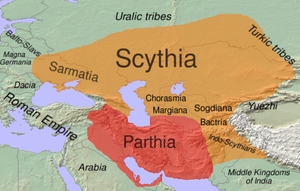Thyssagetae
Thyssagetae (Hindi: थीस्सा-गेटाई , Ancient Greek: Θυσσαγέται) were an ancient tribe described by Herodotus[1]
Contents
Variants
Location
They were occupying a district to the north-east of Scythia (present-day Russia) separated from the Budini by a desert seven days journey broad. From their land four rivers flowed into the Maeotis, but as one of them, the Oarus, is almost certainly the Volga, there must be some mistake about this. They seem to have held the southern end of the Urals about Ufa and Orenburg.
Ta-Yue-Che and Siao-Yue-Che
Bhim Singh Dahiya writes:
- "It is important to note that the Chinese word 'Yue-che" is pronounced as "Gut-tia" according to Karl-Gren, meaning the "Moon People".[2] Later on, the Chinese chronicles show, that under pressure of another tribe of the same stock, called by the Chinese as Hiung-nu or Hoa, the Yue-che moved southward and westward. The branch that was numerically weaker went to the South towards Tibet and were called 'Siao-Yue-Che", meaning the "little Yue-che". The main body moved westward and occupied Dahia (or Tahia, Bactria, Balkh). They were called "Ta-Yue-che" meaning the "Great Guttia" or great Jats. As shown above the word 'Yue-che' is pronounced as Guttia and therefore Ta-Yue-che is exactly the same as the word "Massa Getae" of the Greeks and the Persians. All the Chinese sources agree that the Kusanas were from the Yue-che race. The Chinese author of Thung-Kiang-Nu, writes in the year 555 A.D. that the Aptal or Hephthalites were of the race of Ta-Yue-che. Further the encyclopaedia of Ma-Tuan-g-Lin says that the Yeta are of the race of Ta-Yue-che, and further that the I-Tan belonged to the same race as Yue-che."[3]
Bhim Singh Dahiya goes on to state that:
- "The Chinese were right in stating that the Hiung-nu were a part of the Yue-Che (reads as Guti) people, and these Guti people had two divisions, the Ta-Yue-Che and the Siao-Yue-Che, exactly corresponding to the Massagetae and Thyssagetae of Herodotus (a classical Greek writer of fifth century BC), meaning the "Great-Jats" and the "Little-Jats" respectively. Almost every tribe of Ancient Middle East (West Asia) and Central Asia, is represented among the present day Jats in India."[4]
Mention by Pliny
Pliny[5] mentions....Next to them (Sauromatæ) are the Ævazæ 5, the Coitæ6, the Cicimeni, the Messeniani, the Costobocci, the Choatræ, the Zigæ7, the Dandarii, the Thyssagetæ, and the Iyrcæ8, as far as certain rugged deserts and densely wooded vallies, beyond which again are the Arimphæi9, who extend as far as the Riphæan Mountains.10
5 Hardouin suggests from εὑάζω, "to celebrate the orgies of Bacchus."
6 Perhaps from κοίτν, a "den" or "cavern," their habitation.
7 Parisot suggests that they may have been a Caucasian or Circassian tribe, because in the Circassian language the word zig has the meaning of "man." He also suggests that they were probably a distinct race from the Zingi previously mentioned, whom he identifies with the ancestors of the Zingari or Bohemians, the modern Gypsies.
8 The more common reading is "Tureæ" a tribe also mentioned by Mela, and which gave name to modern Turkistan.
9 The Argippæi of Herodotus and other ancient authors. These people were bald, flat-nosed, and long-chinned. They are again mentioned by Pliny in C. 14, who calls them a race not unlike the Hyperborei, and then, like Mela, abridges the description given by Herodotus. By different writers these people have been identified with the Chinese, the Brahmins or Lamas, and the Calmucks. The last is thought to be the most probable opinion, or else that the description of Herodotus, borrowed by other writers, may be applied to the Mongols in general. The mountains, at the foot of which they have been placed, are identified with either the Ural, the western extremity of the Altai chain, or the eastern part of the Altai.
10 Generally regarded as the western branch of the Ural Mountains.
See also
External links
References
- ↑ Herodotus. Histories, 4.22. "...after the desert, if one inclines somewhat to the east, the Thyssagetae are reached, a numerous nation quite distinct from any other, and living by the chase."
- ↑ Jari-Churpentier, Die-Ethno Graphische Stellung der Toohaser, 1917, Pp. 347-388.
- ↑ Dahiya, Bhim Singh (1980): Jats, the ancient rulers: a clan study (First Edition: 1980). Sterling Publishers Pvt. Ltd. p. 25
- ↑ http://www.iranian.com/History/2005/March/Gutians/
- ↑ Natural History by Pliny Book VI/Chapter 7
Back to Variants of Jat
